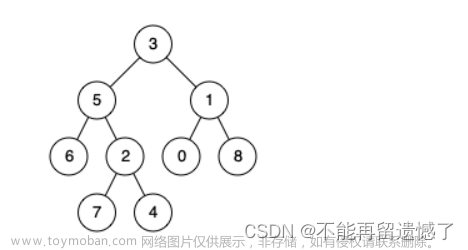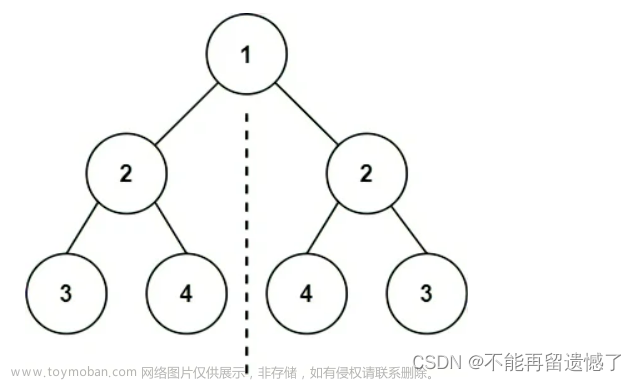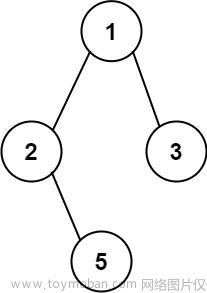前言

继承前面的写作思路,此篇文章继续二叉树的oj题
一、二叉树的最小深度
1.题目介绍
题目在力扣 二叉树的最小深度
2.思路
最小深度是从根节点到最近叶子节点的最短路径上的节点数量,叶子节点是没有子节点的节点,那么叶子节点的是不是只可能出现在一个字数遍历完才会出现,所以这题我们就可以转化成一个遍历到叶子的最短路径,那么们就会出现下面这种情况,这种情况数出5,即返回右子树的最小深度

所以我们可以总结成以下几点
1.如果root为空,则返回0;
2.如果左节点为空,那么直接返回右节点的最小深度+1即可
3.如果左节点为空,那么直接返回右节点的最小深度+1即可
4.如果两者都不为空,我们就返回左节点和右节点中小的那个节点+1
3.代码
/**
* Definition for a binary tree node.
* struct TreeNode {
* int val;
* struct TreeNode *left;
* struct TreeNode *right;
* };
*/
int minDepth(struct TreeNode* root){
if(root==NULL)
return 0;
if(root->left==NULL)
return minDepth(root->right)+1;
else if(root->right==NULL)
return minDepth(root->left)+1;
int left=minDepth(root->left);
int right=minDepth(root->right);
if(left<right)
{
return left+1;
}
else
{
return right+1;
}
}
二、完全二叉树的节点个数
1.题目介绍
题目在力扣完全二叉树的节点个数 文章来源:https://www.toymoban.com/news/detail-407452.html
文章来源:https://www.toymoban.com/news/detail-407452.html
2.思路
本题考的就是层序遍历,将这课二叉树层序遍历一遍就行了,层序就是建立一个队列,利用队列的先进先出的性质,每pop一个节点,就依次带入其非NULL节点的左节点和右节点,如下图
你可以用数组模拟队列,也可以直接拿队列的代码来弄文章来源地址https://www.toymoban.com/news/detail-407452.html
3.代码
/**
* Definition for a binary tree node.
* struct TreeNode {
* int val;
* struct TreeNode *left;
* struct TreeNode *right;
* };
*/
typedef struct TreeNode* QDatatype;
typedef struct QueueNode
{
struct QueueNode* next;
QDatatype Data;
}QNode;
typedef struct Queue
{
QNode* head;
QNode* tail;
int size;
}Queue;
void QueueInit(Queue* pq)
{
assert(pq);
pq->head = pq->tail = NULL;
pq->size = 0;
}
void QueueDestroy(Queue* pq)
{
assert(pq);
QNode* cur = pq->head;
while (cur)
{
QNode* next = cur->next;
free(cur);
cur = next;
}
pq->head = pq->tail = NULL;
pq->size = 0;
}
void QueuePush(Queue* pq, QDatatype x)
{
assert(pq);
QNode* newnode = (QNode*)malloc(sizeof(QNode));
assert(newnode);
newnode->Data = x;
newnode->next=NULL;
if (pq->size == 0)
{
pq->head =pq->tail= newnode;
}
else
{
pq->tail->next = newnode;
pq->tail = newnode;
}
pq->size++;
}
void QueuePop(Queue* pq)
{
assert(pq);
assert(pq->size);
if (pq->head->next==NULL)
{
free(pq->head);
pq->head =pq->tail= NULL;
}
else
{
QNode* next = pq->head->next;
free(pq->head);
pq->head = next;
}
pq->size--;
}
int QueueSize(Queue* pq)
{
assert(pq);
return pq->size;
}
bool QueueEmpty(Queue* pq)
{
assert(pq);
return pq->size==0;
}
QDatatype QueueFront(Queue* pq)
{
assert(pq);
assert(!QueueEmpty(pq));
return pq->head->Data;
}
QDatatype QueueBack(Queue* pq)
{
assert(pq);
assert(!QueueEmpty(pq));
return pq->tail->Data;
}
int countNodes(struct TreeNode* root){
if(root==NULL)
return 0;
Queue tree;
Queue* pt = &tree;
QueueInit(pt);
QueuePush(pt,root);
int count=0;
while (!QueueEmpty(pt))
{
struct TreeNode* front = QueueFront(pt);
count ++;
QueuePop(pt);
if (front->left)
{
QueuePush(pt, front->left);
}
if (front->right)
{
QueuePush(pt, front->right);
}
}
QueueDestroy(pt);
return count;
}
到了这里,关于二叉树刷题专练(三)的文章就介绍完了。如果您还想了解更多内容,请在右上角搜索TOY模板网以前的文章或继续浏览下面的相关文章,希望大家以后多多支持TOY模板网!











